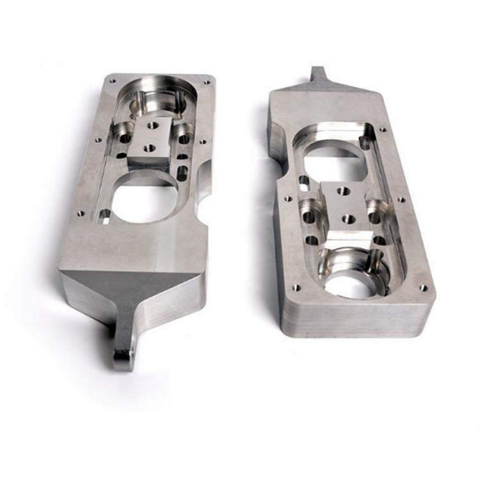Aluminum Casting Company innovations that drive industrial design
Understanding the Environmental Benefits of Aluminum Foundry Techniques
Aluminum foundry methods play an important duty ahead of time sustainability within the production industry. By implementing sophisticated reusing methods and energy-efficient techniques, these methods considerably reduce waste and carbon impacts. Ingenious spreading techniques better boost resource preservation initiatives. As sectors progressively prioritize environmental obligation, comprehending the complete impact of these methods becomes crucial. What particular innovations are leading the way in this change?
The Function of Aluminum in Lasting Production
Lots of materials contribute to lasting production, aluminum stands out due to its special residential properties and recyclability. This light-weight steel is not only durable however also has exceptional rust resistance, making it a perfect choice for numerous applications, from automobile to construction. Its high strength-to-weight proportion results in energy financial savings throughout transport and usage. Furthermore, aluminum can be reused indefinitely without shedding its integral high qualities, promoting a round economy.
The manufacturing process of aluminum has actually developed, incorporating energy-efficient techniques that reduce carbon impacts. By using renewable resource sources, manufacturers are significantly lessening the environmental influence connected with light weight aluminum production. In addition, using recycled light weight aluminum calls for considerably much less energy contrasted to removing and refining key aluminum, bring about reduced greenhouse gas exhausts. As sectors seek sustainable solutions, light weight aluminum's versatility and eco-friendly characteristics position it as a pivotal product in the pursuit of greener manufacturing techniques.
Advanced Recycling Techniques in Aluminum Foundries
Advanced recycling techniques in light weight aluminum factories are revolutionizing the way scrap aluminum is refined and recycled. Cutting-edge approaches, such as closed-loop recycling systems, make it possible for foundries to reclaim aluminum from manufacturing waste and out-of-date products effectively. These systems decrease material loss and enhance the quality of recycled aluminum, making it a viable alternative to primary light weight aluminum production.
Furthermore, advanced sorting innovations, including automated optical sorting and X-ray fluorescence, boost the splitting up of light weight aluminum from other products, ensuring greater pureness levels in recycled results. This precision minimizes contamination, which can compromise the stability of the final product.
Additionally, the assimilation of advanced melting technologies, such as induction melting and energy-efficient heating systems, enhances the recycling process, lowering energy intake. Jointly, these technologies contribute to a much more sustainable aluminum market by decreasing dependence on virgin materials and decreasing greenhouse gas discharges connected with light weight aluminum manufacturing.
Energy Performance Improvements in Foundry Workflow
Energy effectiveness enhancements in aluminum shop procedures can substantially improve sustainability techniques. Implementing waste heat recovery systems enables shops to repurpose excess power, decreasing total power consumption. Additionally, developments in process automation streamline procedures, leading to lowered waste and enhanced resource use.
Waste Heat Healing
Applying waste heat recuperation systems in light weight aluminum shops considerably boosts energy effectiveness by catching and reusing excess thermal power produced during manufacturing processes. These systems facilitate the conversion of wasted heat into usable power, which can be made use of for numerous applications within the factory, such as powering or preheating materials tools. By recovering warmth that would otherwise be eliminated into the setting, foundries can noticeably lower their overall power intake and greenhouse gas discharges. This method not just lowers functional prices however also advertises sustainable techniques within the sector. In addition, the adoption of waste warm recovery technologies lines up with governing requirements targeted at lowering environmental effect, making it a vital element of modern aluminum shop procedures.
Process Automation Benefits
Automating procedures in aluminum shops can greatly enhance energy effectiveness by optimizing manufacturing workflows and minimizing waste. By executing sophisticated technologies such as robotics and artificial intelligence, factories can improve procedures, reducing unneeded energy usage. Automated systems assist in accurate control over temperature and material handling, making sure that energy is utilized only when required. In addition, real-time surveillance allows for prompt adjustments, minimizing the threat of power loss. The integration of automation not just improves productivity yet additionally reduces functional prices, making factories extra competitive. Consequently, these energy-efficient methods contribute considerably to sustainability objectives, lowering the environmental footprint of light weight aluminum production while satisfying enhancing market demands - Aluminum Foundry. Improved energy efficiency with automation represents an essential step in the direction of greener shop procedures
Minimizing Waste Through Ingenious Casting Approaches
Ingenious spreading methods play an essential duty in decreasing waste in light weight aluminum factories. Strategies such as innovative molding and the usage of recyclable materials substantially lessen production scrap. These methods not just improve performance but likewise contribute to an extra lasting production process.
Advanced Molding Techniques
As markets progressively focus on sustainability, progressed molding methods in aluminum foundries arise as effective services for lowering waste. These innovative techniques, such as 3D printing and accuracy mold production, considerably improve the efficiency of the casting procedure. By utilizing computer-aided style (CAD) and simulation innovations, producers can enhance mold geometry, decreasing product usage while keeping item integrity. Furthermore, progressed methods make it possible for the production of intricate forms that conventional methods can not achieve, reducing the requirement for extra machining and thus reducing scrap product. The flexibility of these techniques permits rapid prototyping, additional lowering lead times and power consumption. On the whole, the implementation of sophisticated molding strategies stands for an essential step toward ecologically liable aluminum manufacturing, straightening with global sustainability objectives.
Recyclable Material Application
Recyclable materials play a critical function in decreasing waste within aluminum foundries, changing the casting landscape through their effective utilization. By including scrap light weight aluminum and various other recyclable elements right into the production procedure, factories can considerably lower the need for virgin products. This not only conserves natural resources however also decreases power usage linked with mining and refining. Ingenious casting techniques, such as die casting and sand casting, enable seamless check this site out integration of these products, making certain top quality results. The usage of recyclable materials promotes a round economy, where resources are continually recycled and repurposed, reducing land fill payments. Inevitably, the strategic use of recyclables improves sustainability while promoting cost-effectiveness in light weight aluminum shop operations.
Decreasing Production Scrap

Life Process Evaluation of Light Weight Aluminum Products
Light weight aluminum is widely identified for its sturdy and lightweight residential properties, an extensive Life Cycle Assessment (LCA) reveals the environmental effects associated with its use, disposal, and manufacturing. The LCA process examines the power consumption, greenhouse gas emissions, and source exhaustion linked to aluminum products from extraction of bauxite ore to end-of-life management. Main light weight aluminum production is energy-intensive, commonly depending on fossil gas, which contributes considerably to carbon footprints. In contrast, reusing aluminum provides significant environmental advantages, as it utilizes only a portion of the energy required for primary production. The recycling procedure decreases landfill waste and conserves all-natural sources. The LCA also thinks about the item's durability and potential for reuse, stressing the significance of lasting layout. On the whole, understanding the life cycle effects of light weight aluminum items is essential for making informed choices that prioritize environmental sustainability within the industry.
Instance Researches: Successful Sustainable Practices in the Sector
The light weight aluminum industry has actually begun to welcome cutting-edge lasting methods that deal with the ecological challenges recognized in Life Cycle Analyses. One significant instance is a leading factory that carried out a closed-loop recycling system, significantly decreasing waste and power usage. By reusing scrap aluminum in production, the facility achieved a 40% reduction in its carbon footprint.
An additional instance includes a supplier that took on eco-friendly energy sources, powering its procedures with solar and wind power - Aluminum Foundry. This change not just reduced greenhouse gas emissions however additionally enhanced the company's credibility amongst eco mindful customers
Furthermore, a 3rd shop has actually spent in innovative casting strategies, which maximize product usage and decrease problems, further reducing source intake. These study show that the light weight aluminum industry is qualified of incorporating sustainable techniques, demonstrating both environmental responsibility and financial practicality, ultimately contributing to a much more lasting future.
Often Asked Inquiries
Just How Does Light weight aluminum Contrast to Various Other Metals in Sustainability?
Light weight aluminum is usually taken into consideration extra lasting than lots of steels as a result of its recyclability, lower power demands for production, and minimized environmental impact. Its lifecycle performance goes beyond that of steel and copper in numerous applications.
What Is the Carbon Footprint of Aluminum Foundry Processes?
The carbon footprint of aluminum foundry procedures differs, generally varying from 4 to 15 statistics lots of CO2 per lots of aluminum produced. Factors influencing this include power resources, modern technology, and the performance of procedures.
Exist Health And Wellness Threats Associated With Light Weight Aluminum Shop Workflow?

What Are the Expenses Related To Sustainable Aluminum Techniques?
The expenses connected with sustainable light weight aluminum strategies include greater preliminary investments in technology, prospective rises in functional expenses, and recurring maintenance. These are commonly balanced out by long-term financial savings and minimized environmental influence.

Exactly How Does Light Weight Aluminum Recycling Influence Resident Communities?
Light weight aluminum recycling positively influences neighborhood areas by producing work, minimizing land fill waste, and reducing power expenses. It fosters financial growth and advertises environmental stewardship, leading to healthier living conditions and improved community interaction in sustainability efforts.
Furthermore, the usage of recycled light weight aluminum calls for substantially much less power compared to removing and fine-tuning main aluminum, leading to lower greenhouse gas emissions. Advanced reusing strategies in aluminum shops are transforming the means scrap light weight aluminum is refined and recycled. aluminum casting. Carrying out waste heat recuperation systems in aluminum factories significantly enhances energy performance by capturing and recycling excess thermal energy produced throughout manufacturing processes. Automating procedures in aluminum factories can significantly improve power efficiency by enhancing production process and reducing waste. The carbon impact of aluminum factory processes varies, usually ranging from 4 to 15 metric heaps of Carbon dioxide per bunch of aluminum generated